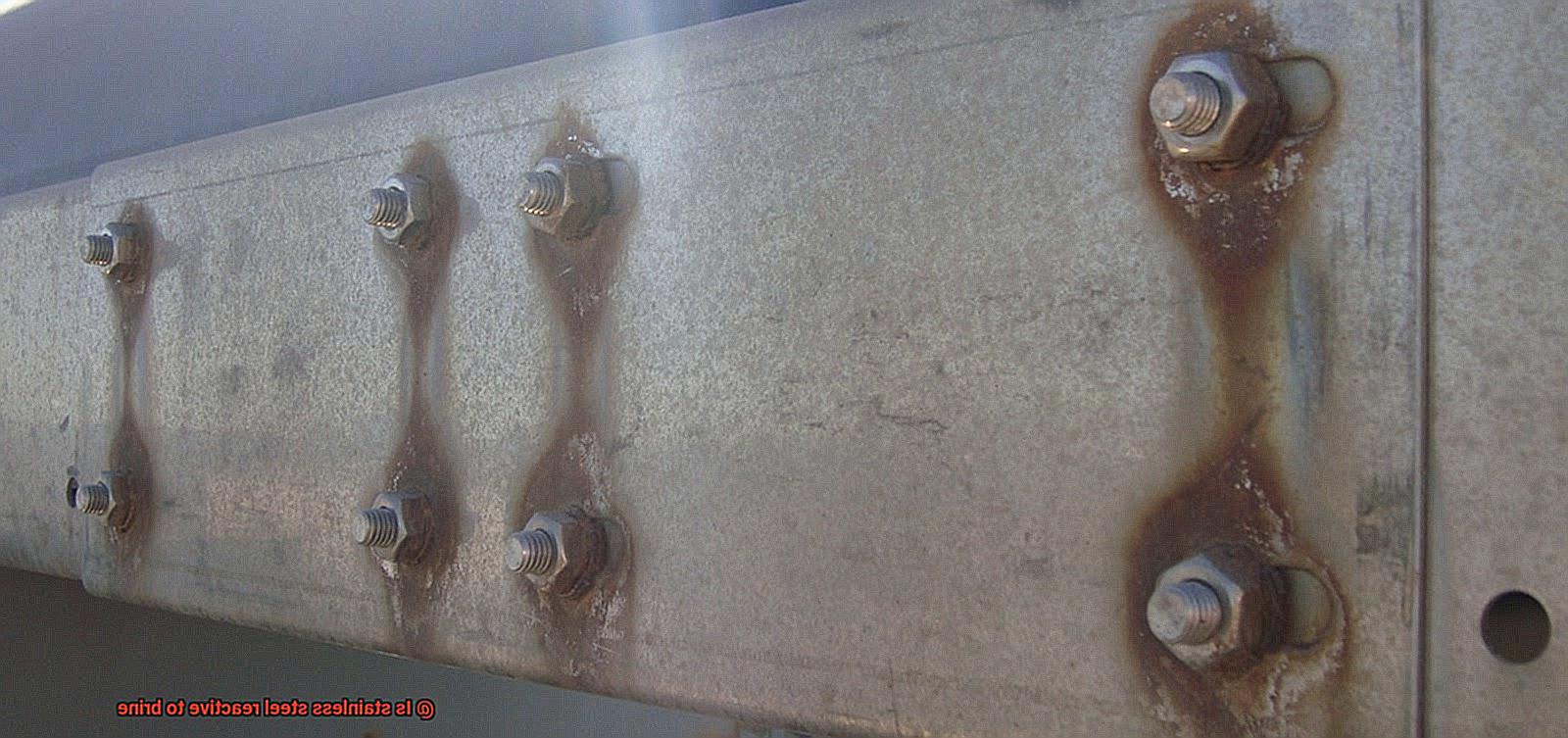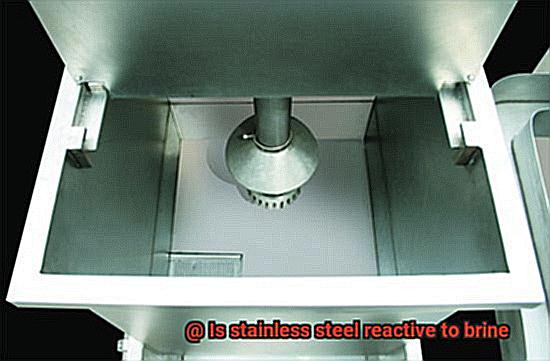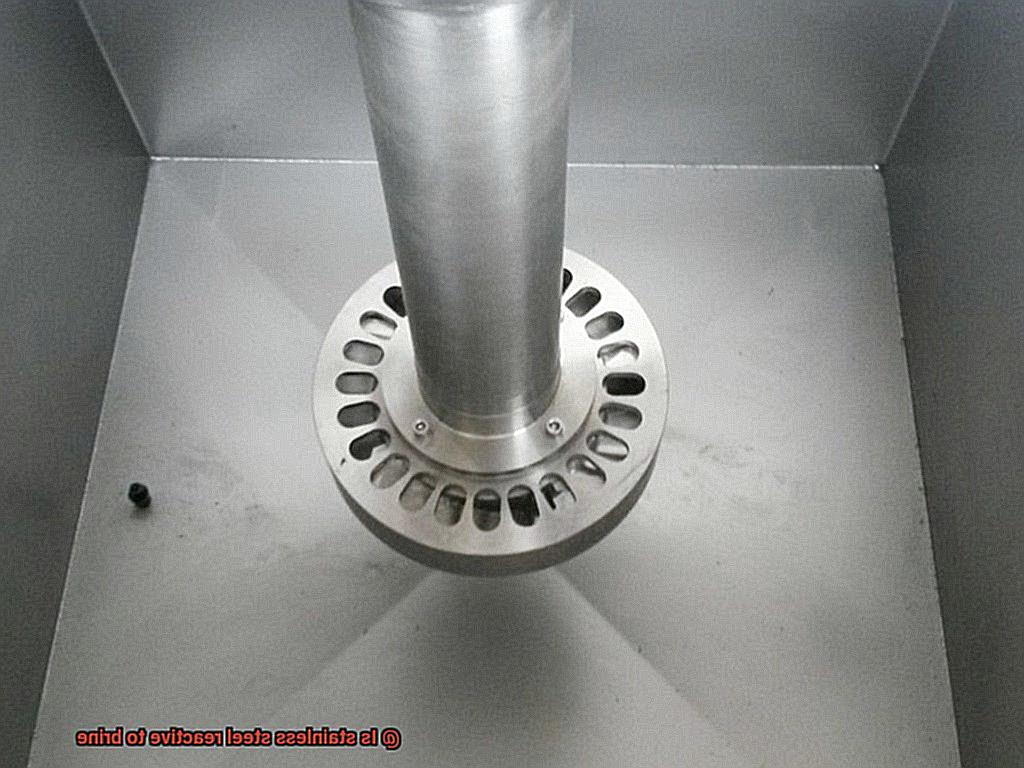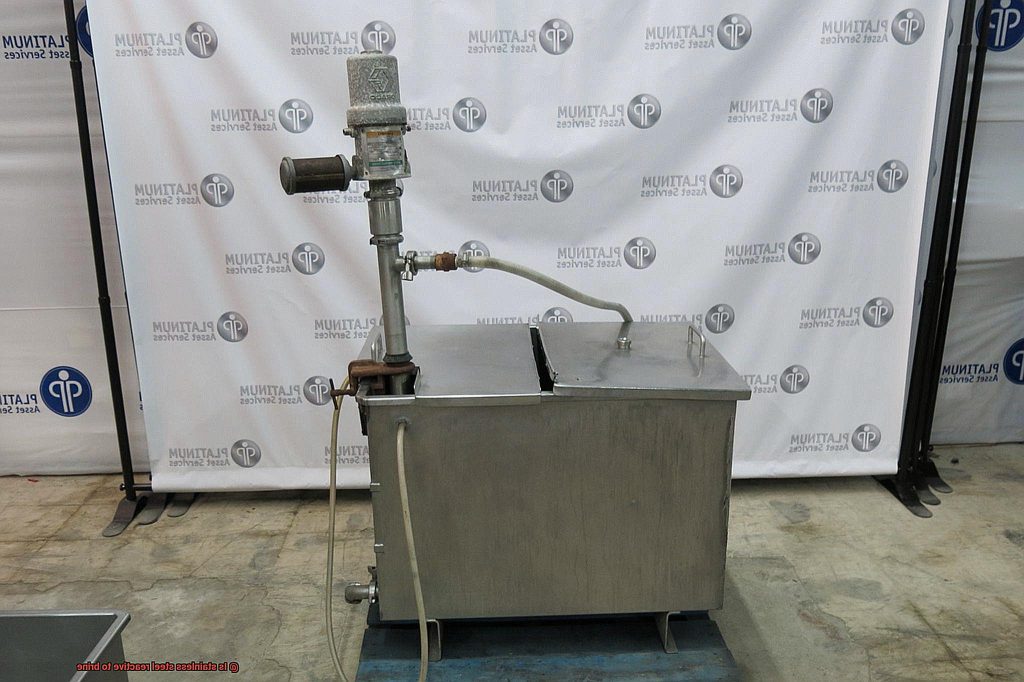Brine, the salty solution that’s been around for centuries, has become a popular ingredient and method in cooking and preserving food. It can tenderize meat, add flavor to veggies, and extend the shelf life of your favorite foods. But, as with any ingredient or method, it’s important to consider its compatibility with different materials. One question that often arises is whether stainless steel is reactive to brine.
Stainless steel is a go-to material for cooking and food preservation because of its durability and corrosion-resistant properties. However, even this tough metal isn’t invincible when it comes to certain substances like brine. When exposed to brine, stainless steel can potentially react negatively, leading to damage or contamination of the food stored or cooked in it.
It’s crucial for anyone who uses stainless steel in their cooking or food preservation to understand its reactivity with brine. Whether you’re a professional chef or a home cook, knowing how brine affects stainless steel can help you make informed decisions and prevent unwanted consequences.
In this blog post, we’ll explore the world of brine and stainless steel by separating fact from myth about their compatibility. We’ll cover what causes stainless steel reactivity with brine, potential risks associated with using them together, and methods for preventing any damage from occurring. So sit tight and get ready for an informative journey into the world of stainless steel and brine.
Contents
What is Stainless Steel?
Stainless steel is more than just a household name – it’s a remarkable material that has revolutionized the way we live and work. From kitchen appliances to medical equipment, stainless steel is everywhere, prized for its strength, durability, and resistance to corrosion.
So, what exactly is stainless steel? At its core, it’s a type of steel that contains at least 10.5% chromium. This may sound like a small amount, but it’s enough to make all the difference. When the chromium comes into contact with oxygen in the air, it forms a thin layer of chromium oxide on the surface of the metal. This invisible layer is what gives stainless steel its incredible resistance to rust and corrosion.

But not all stainless steels are created equal. There are several different types of stainless steel, each with their own unique characteristics. Here are some of the most common types:
- Austenitic stainless steel: Non-magnetic and highly corrosion-resistant, this type of stainless steel is often used in kitchen appliances and utensils.
- Ferritic stainless steel: Magnetic and less corrosion-resistant than austenitic stainless steel, ferritic stainless steel is often used in automotive applications.
- Martensitic stainless steel: Harder and more brittle than other types of stainless steel, martensitic stainless steel is often used in knife blades and other cutting tools.
While stainless steel is known for its resistance to corrosion, certain environments and substances can still cause problems. For example, brine – a mixture of salt and water commonly used for brining meat and fish – can break down the protective layer of chromium oxide on the surface of the metal, leaving it vulnerable to pitting corrosion.
To prevent this type of corrosion when using brine, it’s important to use high-quality stainless steel with a high chromium content (at least 18%). Additionally, you should avoid prolonged exposure to brine, rinse and dry the stainless steel immediately after use, and consider using a protective coating or barrier between the stainless steel and brine.
What is Brine?
Brine – a simple yet versatile mixture of salt and water. It’s a culinary wonder that adds flavor and preservation to our favorite foods, but it’s also an essential component in various industrial processes. Let’s dive deeper into the world of brine and explore its many uses.

Firstly, brine is commonly used as a preservative for food. By immersing meat or vegetables in a brine solution, we can extend their shelf life while also adding a delicious salty taste. The concentration of salt in the brine can vary, typically around 20-25% by weight. But did you know that different types of salt can be used to make brine? Table salt, sea salt, and kosher salt are some examples that come to mind, each with their own unique taste and texture.
But the uses of brine go beyond the kitchen. It’s also widely used in various industrial processes, including oil and gas drilling, desalination, and refrigeration. In oil and gas drilling, brine is used to dissolve rock formations and facilitate the extraction of oil or gas. In desalination plants, it’s used to remove salt from seawater and make it safe for human consumption. And in refrigeration systems, it’s used to absorb heat and transfer it away from a specific area – an essential component in air conditioning units and other cooling devices.
However, one potential issue with brine is its corrosiveness. Because it contains salt, which is highly reactive, it can corrode metal surfaces over time. That’s why it’s crucial to choose high-quality stainless steel with a high chromium content when dealing with brine. Even then, taking precautions such as rinsing and drying immediately after use is essential to prevent any potential damage.
The Reaction Between Stainless Steel and Brine
As a grill master, you want to ensure that your kitchen appliances are of high-quality and can stand the test of time. But, one of the most pressing concerns while grilling is the reactivity of stainless steel with brine. Brine is a solution of salt and water that is often used to marinate meat before grilling. It’s essential to understand the reaction between stainless steel and brine to avoid any potential health hazards.
The presence of chloride ions in salt causes pitting corrosion on some types of stainless steel, creating small holes or pits on the surface of the metal, leading to rusting and degradation. However, not all types of stainless steel are equally reactive to brine. The most commonly used type in kitchen appliances is austenitic stainless steel, which contains high amounts of chromium and nickel, offering excellent corrosion resistance even in the presence of chloride ions.
Interestingly, austenitic stainless steel is also used in marine environments where it’s exposed to saltwater. This indicates that it can withstand exposure to brine when used in grills. However, it’s crucial to note that prolonged exposure to brine can still cause pitting corrosion on some types of stainless steel.
To minimize the risk of pitting corrosion, proper cleaning and maintenance after each use are essential. Removing any excess salt or brine from the surface and using a non-abrasive cleaner will prevent scratching of the surface.
Factors Affecting the Reaction between Stainless Steel and Brine
As a grill master, ensuring that your equipment is in tip-top shape is just as important as perfecting your BBQ sauce recipe. That’s why it’s essential to understand the factors that can affect the reaction between stainless steel and brine. While stainless steel is known for its durability, rust-resistance, and easy-to-clean properties, exposure to brine can cause it to become reactive. This is due to the chloride ions in the brine reacting with the chromium in the stainless steel, causing pitting or corrosion.
In order to prevent this from happening, there are several factors to consider. The first one is the concentration of salt in the brine. The higher the salt concentration, the more reactive your stainless steel will be. So, it’s crucial to use a brine with a lower salt concentration when grilling with stainless steel. By doing this, you’ll be able to reduce the risk of pitting or corrosion.
The second factor to consider is temperature. When exposed to high temperatures, stainless steel can become more susceptible to corrosion. Therefore, it’s important to grill at lower temperatures or use less brine to avoid damaging your equipment.
The type of stainless steel used can also play a significant role in its reactivity to brine. Austenitic stainless steel has a higher resistance to corrosion than ferritic or martensitic stainless steel. Thus, it’s essential to consider the type of stainless steel used when purchasing grill equipment.
Lastly, cleaning and maintenance practices are crucial in preventing reactivity between stainless steel and brine. Salt residue left on your equipment can cause corrosion if not cleaned properly after use. Therefore, always clean your equipment thoroughly after each use and store it in a dry place, away from moisture.
Prevention of Corrosion of Stainless Steel with Brine

Stainless steel is a popular material for equipment, appliances, and structures due to its resistance to corrosion. However, when exposed to brine, stainless steel can become reactive and corrode over time. This can lead to damage and decreased lifespan, which no grill master wants for their beloved equipment.
To prevent corrosion of stainless steel with brine, it’s crucial to take a few steps to ensure longevity and protection. Firstly, selecting the right grade of stainless steel is paramount. With many different types available, each with its own properties and levels of corrosion resistance, it’s essential to choose a grade that is specifically designed to withstand exposure to brine.
Another crucial step in preventing corrosion is proper maintenance and cleaning. Regular cleaning can help remove any salt or contaminants that may be present on the surface of the stainless steel. This can prevent corrosion and extend the life of your equipment.
In addition to these steps, various coatings and treatments can be applied to further protect against corrosion. For example, a coating of zinc or aluminum can act as a barrier between the metal and the brine.
To summarize, preventing corrosion of stainless steel with brine requires careful selection, proper maintenance, and protective coatings or treatments. These steps will ensure that your stainless steel equipment remains resistant to corrosion even when exposed to harsh environments like brine.
Types of Protective Coatings or Barriers for Use With Brine
Stainless steel is a sturdy and durable material that is widely used in various applications, including kitchen appliances and utensils. However, when exposed to brine, which is a mixture of salt and water, stainless steel can corrode and become damaged over time. To prevent this from happening, it’s essential to use high-quality stainless steel with at least 18% chromium content and avoid prolonged exposure to brine. But if you want extra protection, you can use a variety of coatings and barriers specifically designed for use with brine.
Epoxy coatings are highly resistant to corrosion and are one of the most popular types of protective coatings for use with brine. They create a hard, durable barrier that prevents brine from coming into contact with the stainless steel surface. Epoxy coatings are easy to apply on surfaces like stainless steel and can be customized to meet specific needs. They also have excellent adhesion properties, which means they adhere well to the surface they are applied to.
Another option for protecting stainless steel in brine environments is polyurethane coatings. These coatings are highly resistant to corrosion and can withstand exposure to harsh environmental conditions, making them ideal for use in marine settings. Polyurethane coatings provide a strong barrier against brine and are extremely durable, making them an excellent choice for protecting stainless steel surfaces.
If you prefer barriers instead of coatings, there are plenty of options available as well. One popular option is a sacrificial anode, which is a piece of metal that is more easily corroded than stainless steel. When placed near the stainless steel surface, the anode will corrode instead of the stainless steel, preventing damage to the metal. Sacrificial anodes are often made of metals such as zinc or aluminum.
Another option for protecting stainless steel from brine is a cathodic protection system. This system works by applying a small electrical current to the stainless steel surface, causing it to become negatively charged. This negative charge helps prevent corrosion from occurring, making it an effective barrier against brine. Cathodic protection systems are often used in marine environments where corrosion is a significant problem.
Pros and Cons of Using Protective Coatings or Barriers with Brine
When it comes to stainless steel equipment that interacts with brine, protective coatings or barriers can be a game-changer. Materials such as epoxy, polyurethane, or Teflon can all be used to create these coatings and barriers. On the plus side, these protective measures can significantly increase the lifespan of equipment by reducing corrosion caused by brine. This can ultimately save money in the long run by reducing maintenance costs and preventing premature equipment replacement.
However, there are also downsides to using protective coatings or barriers. Firstly, they can be expensive and time-consuming to apply, especially when dealing with large or complex equipment. Secondly, coatings may not be able to withstand high temperatures or pressure and may crack or peel over time leading to moisture penetrating the coating and coming into contact with the stainless steel, which can lead to corrosion.
Another potential issue with using protective coatings or barriers is that they may affect the performance of the equipment. For example, a coating on a heat exchanger may reduce its ability to transfer heat efficiently. In addition, coatings or barriers can make it challenging to inspect and maintain the equipment as they may hide defects or damage.
If you are considering using protective coatings or barriers with brine, it’s important to weigh up the pros and cons before making any decisions. Here are some things to consider:
Pros:
- Increases lifespan of equipment
- Reduces corrosion caused by brine
- Saves money in the long run
Cons:
- Expensive and time-consuming to apply
- May not withstand high temperatures or pressure
- May affect equipment performance
- Can make it difficult to inspect and maintain equipment
sqLw0dVwwM0″ >
Conclusion
To sum up, stainless steel is a game-changing material that has transformed our lives and work. However, it’s important to note that even the most robust metal can react negatively to certain substances like brine, leading to damage or contamination of food stored or cooked in it. Therefore, it’s crucial for anyone who uses stainless steel in their cooking or food preservation to understand its reactivity with brine.
The reaction between stainless steel and brine occurs due to chloride ions present in salt that can break down the protective layer of chromium oxide on the metal’s surface. This leaves it exposed to pitting corrosion. To prevent this type of corrosion when using brine, you should use high-quality stainless steel with a minimum chromium content of 18%, avoid prolonged exposure to brine, rinse and dry the stainless steel immediately after use, and consider using a protective coating or barrier between the stainless steel and brine.
There are several types of protective coatings or barriers available for use with brine, including epoxy coatings, polyurethane coatings, sacrificial anodes, and cathodic protection systems. While these measures can significantly increase equipment lifespan by reducing corrosion caused by brine exposure, they may also be costly and time-consuming to apply and could affect equipment performance.
In conclusion, understanding how brine affects stainless steel is vital as it helps you make informed decisions about your cooking and food preservation methods while ensuring your equipment remains resistant to corrosion even when exposed to harsh environments like brine.






